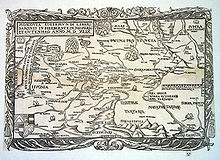Vasili III of Russia
This article needs additional citations for verification. (February 2024) |
| Vasili III | |||||
|---|---|---|---|---|---|
Archangel Cathedral | |||||
| Spouses | |||||
| Issue |
| ||||
| |||||
Sophia Paleologue | |||||
| Religion | Russian Orthodox | ||||
Vasili III Ivanovich (
Foreign affairs

Vasili III maintained the policies initiated by his father Ivan III, focusing much of his reign on consolidating the territorial gains achieved by Ivan. Vasili
Vasili also took advantage of the difficult position of
In 1521 Vasili received an emissary of the neighboring Iranian
Vasili saw some success against the
Vasili was the first grand-duke of Moscow who adopted the title of tsar and the double-headed eagle of the Byzantine Empire.[3]
Family life

By 1526 when he was 47 years old, Vasili had been married to Solomonia Saburova for over 20 years with no heir to his throne being produced. Conscious of her husband's disappointment, Solomonia tried to remedy this by consulting sorcerers and going on pilgrimages. When this proved unsuccessful, Vasili consulted the boyars, announcing that he did not trust his two brothers to handle Russia's affairs.[citation needed]
The boyars suggested that he take a new wife, and despite much opposition from the clergy, he divorced his barren wife and married Princess
He had three brothers:
Death
Whilst out hunting on horseback near Volokolamsk, Vasili felt a great pain in his right hip, the result of an abscess. He was transported to the village of Kolp, where he was visited by two German doctors who were unable to stop the infection with conventional remedies. Believing that his time was short, Vasili requested to be returned to Moscow, where he was kept in the Saint Joseph Cathedral along the way. By 25 November 1533, Vasili reached Moscow and asked to be made a monk before dying. Taking on the name Varlaam, Vasili died at midnight, 3 December 1533.[5]
Ancestry
| Ancestors of Vasili III of Russia | ||||||||||||||||||||||||||||||||||||||||||||||||||||||||||||||||||||||||||||||||||||||||
|---|---|---|---|---|---|---|---|---|---|---|---|---|---|---|---|---|---|---|---|---|---|---|---|---|---|---|---|---|---|---|---|---|---|---|---|---|---|---|---|---|---|---|---|---|---|---|---|---|---|---|---|---|---|---|---|---|---|---|---|---|---|---|---|---|---|---|---|---|---|---|---|---|---|---|---|---|---|---|---|---|---|---|---|---|---|---|---|---|
| ||||||||||||||||||||||||||||||||||||||||||||||||||||||||||||||||||||||||||||||||||||||||
Vasili III in culture
Vasili was the subject of the opera Neprigozhaya by composer Ella Adayevskaya
See also
- Bibliography of Russian history (1223–1613)
- Rulers of Russia family tree
References
- ISBN 9781848325043.)
{{cite book}}: CS1 maint: location missing publisher (link - ISBN 9780534586980.
- ^ a b c One or more of the preceding sentences incorporates text from a publication now in the public domain: Bain, Robert Nisbet (1911). "Basil s.v. Basil III.". In Chisholm, Hugh (ed.). Encyclopædia Britannica. Vol. 3 (11th ed.). Cambridge University Press. pp. 468–469.
- ^ Relations between Tehran and Moscow, 1979–2014. Retrieved 22 December 2014.
- ^ ISBN 2-08-064473-4.



